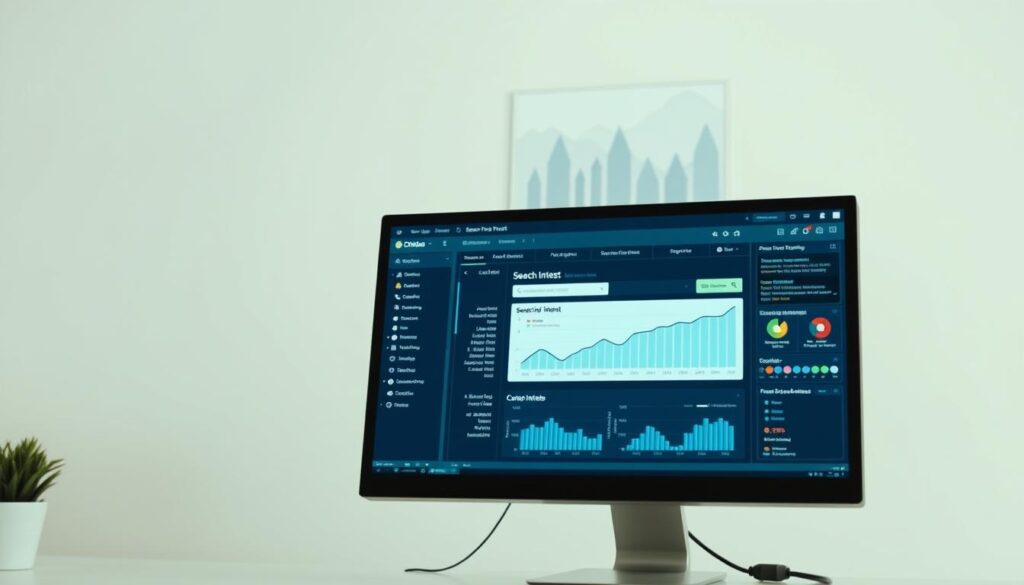Digital marketing experts know that SERP analysis is key to good SEO. Search Engine Results Pages (SERPs) have changed a lot. Now, they are complex places where being seen is everything.
To get SERP features, you need to understand how search engines show results. Google and others now offer rich, interactive experiences. These include things like featured snippets, knowledge panels, and local business listings.
Crowley Media Group is great at figuring out these complex SERP systems. We look at how different types of content rank and what strategies work best. Today, SERP analysis is not just about keywords. It’s about knowing what users want and giving them exactly that.
Key Takeaways
- SERP analysis reveals critical insights into search engine ranking strategies
- Modern search results include diverse multimedia and interactive features
- Understanding user intent is crucial for effective search optimization
- Top-ranking pages leverage multiple content formats and engagement techniques
- Search engine algorithms continuously evolve, demanding adaptive strategies
Understanding SERP Features and Components

Search engine results pages (SERPs) have changed a lot from the old days. Now, they show a mix of features that affect how we see and use websites. This change is big for making websites better and for users too.
Today, search engines show info in many ways, not just simple links. These new features help users find what they need fast. They also give businesses a chance to be seen more online.
Featured Snippets and Zero Position Results
Featured snippets are a big deal in search rankings. They are short answer boxes at the top of search results. They give users quick answers to their questions.
- Extracted directly from top-ranking web pages
- Appear before traditional organic listings
- Typically answer specific questions
Only 1.53% of Google search results don’t have any SERP features. This shows how important these features are.
Rich Snippets and Knowledge Panels
Rich snippets add extra info to search results. They include things like star ratings and prices. Knowledge panels give a lot of info about a topic, using Google’s big database.
Local Pack and Shopping Results
Local pack results are key for businesses with a physical place. They show three local businesses on a map. Shopping results let users see products, prices, and buy directly from the search page.
By knowing and using these SERP features, businesses can get more seen online. They can also get more people visiting their sites.
The Importance of Search Intent in SERP Rankings

Understanding search intent is key to good keyword research and user experience. Search engines like Google are very good at figuring out why people search for things. They aim to show content that exactly matches what users are looking for.
Search intent usually falls into four main types:
- Informational: Users looking for answers or knowledge
- Navigational: Searching for a specific website or page
- Transactional: Ready to buy
- Commercial Investigation: Researching before making a purchase
About 99% of all search terms fall into these categories. Google’s algorithm focuses on understanding what users want. When content matches search intent well, websites can see a big boost in visitors.
Keyword research is vital for finding the intent behind search queries. By looking at People Also Ask boxes and top content, marketers can create strategies that meet user needs.
This approach can lead to a 40% increase in organic traffic. Search engines favor content that gives users exactly what they need.
User experience is also very important. Content that quickly answers questions helps keep users engaged. The goal is to create content that directly addresses what users are searching for.
SERP Analysis: Methods and Best Practices
Doing a good SERP analysis is key for digital marketers and SEO experts. It helps them see how to make their content and SEO better. This means looking closely at search engine results to find ways to improve.
To do well in SERP analysis, you need strong tools and to know important metrics. Here are the main ways to get good at checking search results:
Essential Tools for SERP Analysis
- Google Search Console for tracking organic performance
- SEMrush for comprehensive keyword insights
- Ahrefs for competitive link building research
- Moz Pro for domain authority evaluation
Tracking SERP Performance Metrics
Important metrics to watch include:
- Click-through rates (CTR)
- Average search position
- Featured snippet appearances
- Organic traffic volume
Mobile vs Desktop SERP Considerations
It’s important to know the differences between mobile and desktop search results. Mobile searches often show different layouts and focus on local results. Your link building plans should take these differences into account to get seen on all devices.
By using these SERP analysis methods, marketers can make their search rankings better. This helps bring more organic traffic to their sites.
Competitive Analysis Through SERP Evaluation

Doing a deep dive into competitor analysis through SERP evaluation gives us key insights. Digital marketers can find out a lot by looking at top pages and their stats.
Important parts of competitor analysis include:
- Finding out who’s doing well for certain keywords
- Looking at how they structure their content
- Checking out multimedia and how people interact with it
- Examining their backlinks and how strong their domain is
Good SERP analysis shows us what makes top content stand out. Tracking SERP features like featured snippets and knowledge panels can give you an edge. Most top competitors get these special spots.
Today’s SEO tools help us get quick insights. Tools like SEMrush and Ahrefs give us:
- How hard it is to rank for certain keywords
- Estimates of how much organic traffic they get
- Detailed backlink analyses
- Help finding content gaps
By knowing what competitors are good at and where they’re weak, businesses can make better plans. Keeping up with changes and tweaking content is crucial to stay ahead online.
Advanced Techniques for Content Optimization Based on SERP Data
Search engine optimization keeps getting more complex. It needs smart strategies to show up in searches. Using advanced techniques can boost your rankings and keep users interested.

Digital marketers today must use many strategies to stand out. With Google handling 3.5 billion searches every day, making your content stand out is key.
Targeting Featured Snippets and Rich Results
To get featured snippets, you need to structure your content well. Here are some tips:
- Make answers to common questions short and direct
- Use clear headings
- Add schema markup for better context
- Format content in easy-to-read ways like lists and tables
Voice Search Optimization Techniques
Voice Search Optimization is vital with the growth of smart devices. Businesses can improve by:
- Writing in a conversational style
- Targeting long-tail, question-based keywords
- Providing quick, direct answers
- Optimizing for local search queries
Technical SEO Considerations
Technical aspects are still crucial for optimizing content. Focus on:
- Speeding up page loading
- Making sure your site works well on mobile
- Following Core Web Vitals advice
- Creating structured, rich content
By using these advanced strategies, websites can improve their search visibility and user engagement.
Leveraging SERP Features for Better Visibility
To get more visibility in Search Engine Results Pages (SERP), you need to optimize different digital features. Today’s SERP analysis shows many ways for businesses to shine, beyond just ranking well.
Some key SERP features that can really boost your online presence include:
- Featured Snippets: These ‘position zero’ snippets can make your click-through rates jump by up to 30%
- Knowledge Panels: They show off your brand’s full info
- Local Packs: These are vital for businesses that serve specific areas
- People Also Ask (PAA) Boxes: They make users more likely to interact with your content
- Video and Image Carousels: They help keep users engaged with your content
To optimize your content, focus on structured data, clear answers, and targeting specific SERP features. This way, you can get more visibility, even if you’re not at the top of search results.
The best strategy mixes technical SEO with content that users love. By understanding what users are searching for and creating content that answers their questions, you can get into the top spots on SERP.
New SERP features keep popping up, so it’s key to keep learning and adapting. Regularly checking your SERP performance helps you stay ahead and keep your online presence strong.
Conclusion
SERP analysis is not a one-time task. It’s a continuous process that needs ongoing attention and strategic changes. By understanding ranking factors and using targeted optimization, businesses can boost their search engine visibility. This attracts more potential customers.
Successful digital marketing depends on effective SERP analysis. Metrics like click-through rates, domain authority, and content relevance are key. Search engines keep changing, so your strategy must stay flexible and adapt to new algorithms.
If you need help in the complex world of SEO, Crowley Media Group is here for you. Their team of experts can create a strong SERP analysis strategy for your business. Call them at (916) 572-9755 or visit crowleymediagroup.com to improve your online marketing.
The digital world is competitive. To stay ahead, you must keep learning, implement strategies, and be ready to adapt. With the right SERP analysis approach, your business can achieve long-term online success and growth.
FAQ
What exactly is SERP analysis?
Why are search intent and SERP features important?
What tools are best for conducting SERP analysis?
How do featured snippets impact search visibility?
What are the key metrics to track in SERP analysis?
How does mobile SERP differ from desktop SERP?
What is the role of schema markup in SERP optimization?
How important is competitive analysis in SERP strategy?
What are People Also Ask (PAA) boxes, and why do they matter?
How does voice search impact SERP optimization?
Source Links
- https://www.searchenginejournal.com/mastering-serp-analysis-guide-to-understanding-search-engine-results-pages/536469/
- https://medium.com/@chetonaabdullah00014/mastering-serp-analysis-a-step-by-step-guide-6a7bf027dc45
- https://www.linkedin.com/pulse/mastering-serp-analysis-comprehensive-guide-understanding-search-iezpc
- https://www.semrush.com/blog/serp-features-guide/
- https://backlinko.com/hub/seo/serp-features
- https://backlinko.com/hub/seo/search-intent
- https://moz.com/learn/seo/search-intent
- https://www.abstraktmg.com/what-is-search-intent/
- https://aioseo.com/what-is-serp-analysis/
- https://www.growandconvert.com/seo/how-to-do-serp-analysis/
- https://www.wincher.com/blog/serp-analysis-step-by-step-guide
- https://competitors.app/serp-competitor-ranking/
- https://seranking.com/blog/serp-analysis/
- https://www.semrush.com/blog/serp-analysis/
- https://www.hillwebcreations.com/marketing-research/serp-analysis/
- https://backlinko.com/advanced-seo
- https://outreachz.com/blog/what-is-a-serp-and-serp-features/
- https://www.dashclicks.com/blog/serp-analysis
- https://blog.hubspot.com/marketing/serp-features
- https://rankmath.com/blog/serp-analysis/
- https://phillipstemann.com/how-to-do-serp-analysis/








